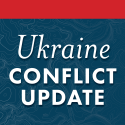Turkey Juggles Relationships after Russia’s Invasion of Ukraine
Feb 26, 2022 - ISW Press
Turkish President Recep Tayyip Erdogan is calling for a decisive NATO response against Russia after the Kremlin began a large-scale invasion of Ukraine on February 24. Turkey has been prioritizing its bourgeoning defense and diplomatic partnership with Ukraine in recent years—an action that the Kremlin perceives as a challenge to its sphere of influence. Ukraine is not the first theater of conflict where Turkey and Russia have opposing interests, which they often have been able to compartmentalize. Turkey has challenged Russia’s sphere of influence in various theaters—including Libya, Central Asia, Syria, and the Caucasus—while maintaining its close coordination with Russia in its efforts to diversify its relations toward non-NATO states. However, Ukraine is likely the most significant challenge to date to Turkey’s bid to balance its NATO membership with its fragile partnership with Russia. Turkey has become increasingly reliant on Russian cooperation in various conflicts and key industries like energy and tourism.










